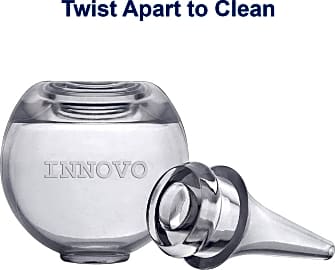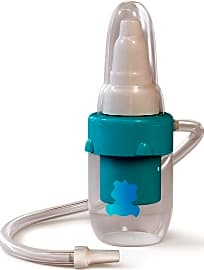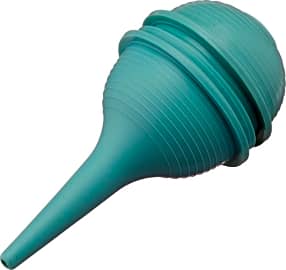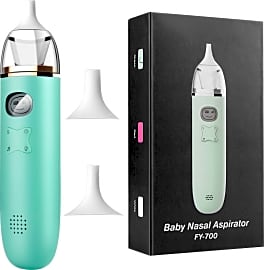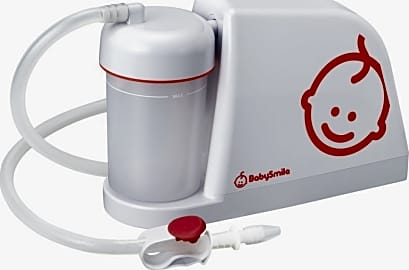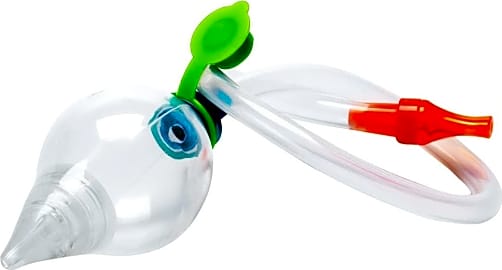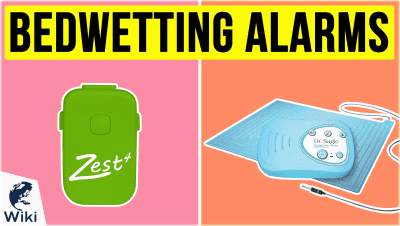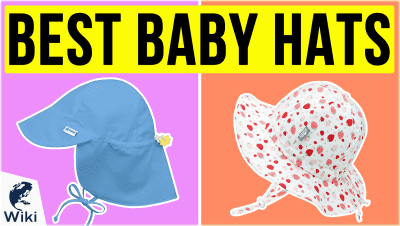The 10 Best Nasal Aspirators

This wiki has been updated 46 times since it was first published in June of 2015. Keeping babies' nostrils clear of mucus can be a challenging task, but it's essential for their comfort when they are congested, and may also help prevent secondary infections when they become sick. Any one of these nasal aspirators can make this potentially messy task, hygienic, safe, and pain-free to minimize distress to little ones and ease their breathing quickly. When users buy our independently chosen editorial recommendations, we may earn commissions to help fund the Wiki.
Editor's Notes
July 14, 2020:
Of all the pieces of equipment they need to buy, most parents may not give a lot of thought to a nasal aspirator, until they get home from the hospital and realize the simple one they were sent home with is impossible to clean and sanitize. The simple bulb aspirator is an effective option, but parents can also choose an oral or electric aspirator as well.
For this update we kept the electric Nosiboo Pro as our top choice even though it's a lot more than some families will need. If you are going to use this with multiple children, or have a baby who suffers from a lot of colds, it may be worth the investment. The best thing about this unit is that even though it's a lot more complex than the average aspirator, the only thing to clean is the suction compartment at the end of the tubing.
For parents looking for something automatic, but more budget-friendly and portable, we added the Comezy FY-700. It doesn't have as much suction or variation as the Nosiboo, but this unit gives you three levels and there's even a light on it for night-time usage.
On the opposite end of the spectrum, the Innovo Twisted Bulb is just like the simple one you'll get from the hospital, but better. Whereas hospital-issue bulbs are opaque, the Innovo is made of medical-grade silicone, so you'll always know how clean it is, plus it can be helpful to see what color goo is coming out of your baby's nose. The other equally important upgrade is that it twists apart so you can thoroughly clean the inside.
The third style of aspirator the oral suction option, which, if you've never heard of it before is more popular than you'd expect. A well-designed choice like the Bubzi Co, when used correctly runs little risk of sucking your child's mucus into your tube. The reason for it's popularity and why you might want to consider this style is that you have absolute control over how much suction you'll be applying.
The Nosefrida Snotsucker is another thoughtfully designed, popular oral option, but keep in mind there are replacement filters to buy and keep track of.
Using A Nasal Aspirator
The mucus and other waste matter will collect within the designated chamber to be cleaned later.
Nasal Aspirators allow parents and caregivers to physically clear mucus and foreign contaminants from a baby's nasal passages using one of a few hygienic methods. Aspirators are either powered electronically using a battery or wall plug, or powered manually using the breath or hand. The effect is instant relief from nasal congestion or obstruction for the child and increased prevention of infections.
It is very important to wash the aspirator before its first use. Pathogens often inhabit them on the trip from the production facility to the baby's nostrils. Once the aspirator has been properly washed, allow it to air dry. Do not heat the units too much with hot water as this may cause volatile organic compounds to release into the air. It can also cause the unit's tubing to warp, preventing proper functioning.
After proper washing and sterilization, a nasal aspirator is ready to use once it is fully dried. It is important to follow the manufacturer's instructions here, as improper use can result in unsuccessful aspiration and a very unhappy baby. The mucus and other waste matter will collect within the designated chamber to be cleaned later. When one finishes using the unit, follow the manufacturer's cleaning instructions. After washing, let the unit air dry and it is ready for the next use.
Are Newborns Always Sick? Why Babies Need Nasal Aspirators.
Nasal aspirators are the ideal solution for clearing the nasal passages in newborn babies, as babies cannot blow their own noses. The question that remains is why these babies produce so much mucus. Many people believe this is caused by respiratory illnesses, which is true in some instances. In many cases, however, the matter pulled from the nasal passages is due to something else entirely.
This becomes a near-involuntary response in many adults, but can sometimes require the outside help of a nasal aspirator in children.
One common misconception is that newborns are born with a cold. The justification for this belief is that most babies are born with a stuffy nose than needs regular cleansing using an aspirator. This isn't a matter of sickness, though. This stuffiness is actually caused by amniotic fluid. The fetus floats in this fluid during pregnancy, and some of this fluid gets into the mouth and nasal passages during birth. It only takes a few days to clear with the help of an aspirator.
It takes a while for babies to figure out the swallowing mechanism. During this time, they are prone to reflux, colloquially known as spit up. This spit up is the regurgitation of formula or breastmilk that has not been properly processed. Most of this reflux comes out the mouth, though some of this regurgitated milk usually passes to their nasal passages, as well. This causes an inflammatory response in the baby's nasal passages, which gives them the symptoms of a stuffy nose.
A human typically breathes in a regular fashion. Inhales follow exhales at roughly the same speed and frequency most of the time. This may be a learned function, as babies do not follow these patterns. It is much more common for a baby to follow an irregular breathing pattern of shallow breaths followed by deeper breaths with varying pauses in between. The sound of this can make the adults believe that the baby sounds stuffy even if they have no obstructions in their nasal passages. Babies with actual symptoms of respiratory distress should see a doctor immediately.
The nasal passages in all humans are equipped with tiny hairs and mucus glands to collect dust, dead skin cells, allergens, and other floating contaminants, keeping them from entering our lungs. This is a normal process and contributes to stuffiness in both babies and adults. One key difference is that babies lack the faculty to sniff or snort up their own mucus to expel it. This becomes a near-involuntary response in many adults, but can sometimes require the outside help of a nasal aspirator in children.
Nasal Aspirators Versus The Bulb Syringe: Is There A Difference?
The blue bulb syringes found in hospitals are actually a very basic form of nasal aspirator. These devices are designed to clear the blocked nasal passages in a newborn who cannot yet blow its nose. There are some key differences between the bulb syringes and their more modern counterparts that make many parents favor one over the other.
Many parents commonly mistake the sheer number of times they see bulb syringes as a sign of their superiority.
Many parents commonly mistake the sheer number of times they see bulb syringes as a sign of their superiority. In actuality, the bulbs are popular in hospitals due to their economical value. Doctors use them to clear the nasal passages of amniotic fluid in the days immediately following birth, though studies indicate this suction may not be necessary. After the amniotic fluid is removed, the syringes are simply thrown away, and a new one is used on the next baby. They serve their purpose well enough to be considered successful.
There are some downsides to these blue bulbs. Firstly, it is nearly impossible to air dry these syringes completely. The dark, damp space provides a perfect breeding ground for bacteria, viruses, and mold. Infants are more susceptible to disease and infection in the earliest stages of life, and reducing or eliminating pathogens should be a high priority for any parent. Other nasal aspirator options are much easier to clean thoroughly and dry completely. This ease coincidentally makes them a much safer choice.
Bulb syringes also have problems with suction. The tip of bulb syringes must be inserted into the babies nose multiple times to make up for the lack of volume and force. This can irritate the infant's delicate inner nose. Nasal aspirators offer greater force and reduced friction, as they have high suction power and need to be inserted much less frequently to be effective.
There are many different nasal aspirators from which to choose. Electronically powered options are available, as well as units powered by human suction or by hand, as is the case with the bulb syringe. The choice is most often seen as a matter of personal preference, but the facts seem to indicate it is time to get rid of the bulb syringe.


